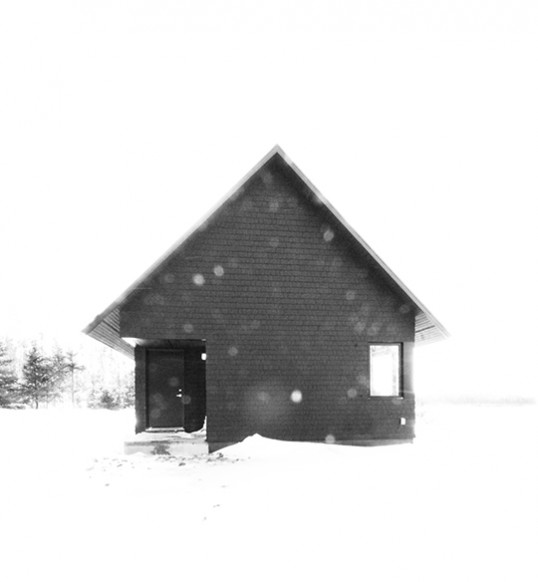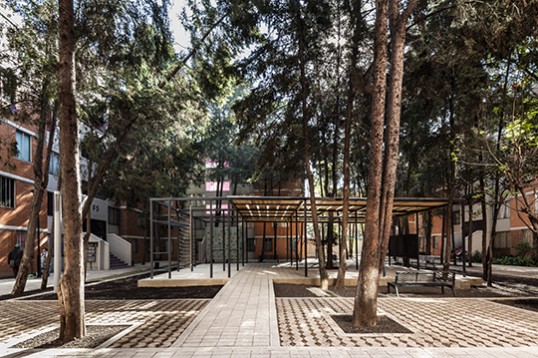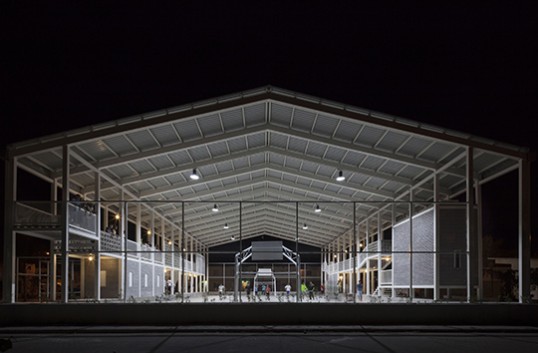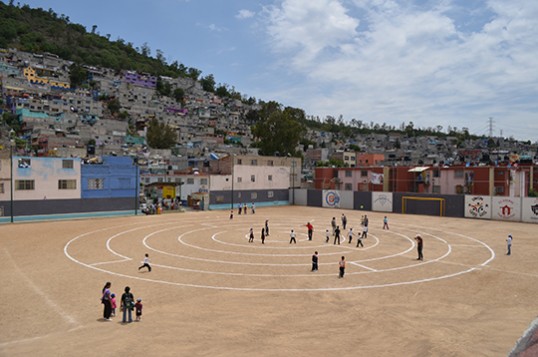On the Table: Dinner with Omar Gandhi & Rozana Montiel
Omar Gandhi and Rozana Monteil joined design professionals and critics to discuss the role of collaboration in their process and how "place gives meaning to space."
November 30, 2016

Guests gathered following lectures by 2016 Emerging Voices Rozana Montiel of Rozana Montiel | Estudio de Arquitectura and Omar Gandhi of Omar Gandhi Architects.
The League’s annual Emerging Voices program recognizes eight firms with distinct design voices, each invited to lecture throughout the month of March and April. Following each night of lectures, the evening’s two presenting firms were joined at dinner by prominent architects, critics, and others in the field for informal and lively conversations.
In the following conversation (which has been edited and condensed), Omar Gandhi of Omar Gandhi Architect and Rozana Montiel of Rozana Montiel | Estudio de Arquitectura joined dinner guests discuss to discuss the role of collaboration in their process and how “place gives meaning to space.”
Sunil Bald, Studio SUMO: One thing I was really struck by tonight was how much the places where you’re based influence your work. Rozana, you’re from Mexico City and work there. Omar, you’re not from Nova Scotia, but it’s where you work. When did your interests begin to be shaped by the place that you were in?
Omar Gandhi, Omar Gandhi Architect: I guess what’s interesting about my situation is that I’m not from Halifax or Nova Scotia, but I’m also not from the city or a rural landscape. I’m from the suburbs. I grew up in Brampton, just outside of Toronto. It was right on the border between new suburban subdivisions and a rural landscape. The high school I went to was in the country, so I’d say that I first started to experience and appreciate that sort of landscape on those morning drives to school.

Omar Gandhi Architect, Black Gables, Nova Scotia, Canada | Photo by Greg Richardson Photography, © Omar Gandhi
Rozana Montiel, Rozana Montiel | Estudio de Arquitectura: Mexico City is complex—it’s really overwhelming. How couldn’t I be compelled to work in and study more about the city with so many things happening around me? I’ve always had an interest in working with people. I think it’s a responsibility there.
Bald: Can you talk about your process of—I don’t want to sound patronizing—educating your clients in terms of architecture as something that will be beneficial in their lives? And how does the work that you do relate to your own design ambitions?
Montiel: It’s difficult sometimes to work with the community. People are trying to survive, so we have found it very difficult to get across the idea that design matters. We’re doing a project with the community of Miravalle, Iztapalapa—recycling an underused dome as a rainwater harvesting structure that supplies potable water. We say we’re going to design this, and they say, “no, no, why are you going to put money into this? You’d better put the money in this other thing.” You have to get them to trust you without giving up your design.
Bald: Omar, it seems like you’ve also been able to persuade your clients to step beyond their original goals. Can you talk about the process of trying to push things?
Gandhi: I’d say that it’s shifted over the last few years. For the first projects that I worked on, it was more about vocabulary. People might be unsure of certain kinds of terms or imagery when talking about modern architecture, so I talked about things that a client would be able to relate to. This isn’t about tricking people, it’s talking about ideas as opposed to imagery. Now, clients who come to me may know a project or two that I’ve done, so there’s already a little bit of background there.

Top: Omar Gandhi Architect, Rabbit Snare Gorge, Nova Scotia, Canada | Photo © Doublespace Photography’ Bottom: Omar Gandhi Architect, Moore Studio, Nova Scotia, Canada | Photo © Greg Richardson Photography
Claire Weisz, WXYStudio: Is working outside of a place that you know well something you want to do?
Gandhi: I’d say that it’s about diligence. If I was going to do a project outside of my region it would be important that I spend time there, that I do research, get to know people. It’s the same sort of thing that I’ve been able to do in my own region. I’m really looking forward to working outside of my comfort zone.
Montiel: For me it’s also really interesting to work outside Mexico City. We have been working with the urbanXchanger research project, sponsored by the Alfred Herrhausen Gesellschaft. With the Berlin-based studio SMAQ, we worked in a community in Mexico for nine days, and then we went to Berlin to work for nine days with local communities there. Of course, I’m interested, but I think you also really need to spend time there and engage with the community.
Weisz: Why do you need collaboration? Why is it critical to what you do?
Montiel: I think it’s really important to work with interdisciplinary partners. We work with agronomists, filmmakers, writers, landscape architects, and others. I start designing, but then they come in and this layering starts. The specialists start mingling and interweaving, and I think they potentialize the project.
Gandhi: I think what’s valuable is getting perspectives from people who see things in a completely different way. It also takes an open-mindedness to rethink or reevaluate some of the perceptions you have about your own ideas.
Susan Rodriguez, Ennead Architects: One of the things I think is very challenging when working in the public realm is the role of leader. Too often these kinds of public processes become compromised—the intentions are great, but the results are not very strong.
Weisz: One of the challenges in public work is to get people to care as much as though they’re a private client, but understand that they’re caring not just for themselves, but for others too. That’s the leadership tipping point. Rozana, I kept looking at your basketball court and wondering at what point did you tell people you were going to make a room, when you couldn’t promise a budget, you didn’t know if you’d be able to do it?
Montiel: After we finished the project, a lady asked me: “Why did you give us such small spaces?” I said, “We gave you spaces. You were not going to have any of this,” and then she understood that we gave the community more than what people expected with the same budget. There are more rooms because they are in between the structure. So, yes, it’s difficult.
Rodriguez: There are a lot of architects who make major public work and it’s all about them. How joyful you must have felt with seeing the interaction with what you’ve made. The way you expressed the client’s interaction with what you’ve made really is motivating.
Montiel: It was really interesting to go to the court after we finished the construction of the roof. [After] spending the whole day there with the photographers and with people—we didn’t want to leave the space. We saw the children playing and being so happy. And the photographers didn’t want to leave either. There’s a difference between designing and experiencing [a project]. When I experienced [the court], I really felt it was successful.
Larry Wayne Richards, Professor and Dean Emeritus, John H. Daniels Faculty of Architecture, Landscape, and Design, University of Toronto: I’m curious to whom you really look for your inspiration—architects or urbanists or neither of the above. In your case, Omar, one international and one Canadian. Rozana, one international and one Mexican.
Gandhi: There’s no one I look up to more than Renzo Piano, not necessarily stylistically, but for very clear evidence of responding to varying criteria, whether it’s the user of the landscape or the environment. As a Canadian example, there’s no one I look up to more than the Patkaus, who may be closer to my work. They are finding the answer through the process. There’s an honest process in both of their practices. On the flip side, there’s nothing that I am less interested in than someone who’s sort of rubber stamping or imposing formal ideas regardless of those other parameters.
Montiel: In Mexico, Alberto Kalach. He’s powerful and intense, and he really understands structure. I also admire the work designed by my husband Mauricio Gomez de Tuddo. He’s also an architect, and he’s very inspiring. He has these really interesting projects, including an observatory and a maze. Internationally, I will say Peter Zumthor and Bijoy Jain of Studio Mumbai. I think they go to the essential. They work with materiality really well.
Bald: Rozana, what strikes me in your work is that you make public space by actually putting something in it. You make a framework for activity, an open frame—like the structure of the basketball court, the kind of space that things hang off of. Otherwise it would just be empty. I wonder if when acting globally as architects, it is more productive to develop methodological strategies rather than prototypical design responses. A Mexican barrio with different kind of tweaks could be in Africa, Rio, or anywhere. But there are certain conditions, even morphological conditions, that influence its growth, and as an architect that you would begin to act on. Can global responses be learned in a local place and used in other contexts?
Montiel: You have a process. You have a methodology. And you go to another place and assume the characteristics of that place, and then you transform it. It depends on the site, so the results will change, of course.
Weisz: Another take on Sunil’s line of questioning—and what is for me refreshing about both of your practices—is that you don’t value a standalone building over the idea of space. It feels like both of you place value on figuring out the process by which you create space. Do you think that you’re trying to explain through your process the value of space—great space, poetic space, playful space?
Rodriguez: I would say that as a counterpoint to that or maybe in support of that, is also a keen awareness of the condition of the place. I think the big issue is having time to understand fundamentally the place in which you are operating. You see people with global practices who are less successful with their responses because they don’t spend enough time to really fuse with a place.
Montiel: I think the difference is that space for me is more abstract. We want to create poetic spaces, but place gives meaning to that space. And to give meaning, to [create] experience and interaction, needs time. So, yes, time is very important in my projects.
Gandhi: I think that the way I would approach it would be to [spend] time studying precedent as well. Whether it’s traditional precedent or more recent architectural precedent of an area, I think there’s a lot to learn from previous successes.




